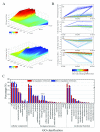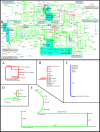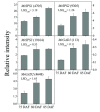Transcriptomic analysis of Chinese bayberry (Myrica rubra) fruit development and ripening using RNA-Seq
- PMID: 22244270
- PMCID: PMC3398333
- DOI: 10.1186/1471-2164-13-19
Transcriptomic analysis of Chinese bayberry (Myrica rubra) fruit development and ripening using RNA-Seq
Abstract
Background: Chinese bayberry (Myrica rubra Sieb. and Zucc.) is an important subtropical fruit crop and an ideal species for fruit quality research due to the rapid and substantial changes that occur during development and ripening, including changes in fruit color and taste. However, research at the molecular level is limited by a lack of sequence data. The present study was designed to obtain transcript sequence data and examine gene expression in bayberry developing fruit based on RNA-Seq and bioinformatic analysis, to provide a foundation for understanding the molecular mechanisms controlling fruit quality changes during ripening.
Results: RNA-Seq generated 1.92 G raw data, which was then de novo assembled into 41,239 UniGenes with a mean length of 531 bp. Approximately 80% of the UniGenes (32,805) were annotated against public protein databases, and coding sequences (CDS) of 31,665 UniGenes were determined. Over 3,600 UniGenes were differentially expressed during fruit ripening, with 826 up-regulated and 1,407 down-regulated. GO comparisons between the UniGenes of these two types and interactive pathways (Ipath) analysis found that energy-related metabolism was enhanced, and catalytic activity was increased. All genes involved in anthocyanin biosynthesis were up-regulated during the fruit ripening processes, concurrent with color change. Important changes in carbohydrate and acid metabolism in the ripening fruit are likely associated with expression of sucrose phosphate synthase (SPS) and glutamate decarboxylase (GAD).
Conclusions: Mass sequence data of Chinese bayberry was obtained and the expression profiles were examined during fruit ripening. The UniGenes were annotated, providing a platform for functional genomic research with this species. Using pathway mapping and expression profiles, the molecular mechanisms for changes in fruit color and taste during ripening were examined. This provides a reference for the study of complicated metabolism in non-model perennial species.
Figures







References
-
- Chen K, Xu C, Zhang B, Ferguson IB. Red bayberry: botany and horticulture. Hortic Rev. 2004;30:83–114.
-
- Zhang B, Kang M, Xie Q, Xu B, Sun C, Chen K, Wu Y. Anthocyanins from Chinese bayberry extract protect β cells from oxidative stress-mediated injury via HO-1 up-regulation. J Agric Food Chem. 2010;59(2):537–545. - PubMed
-
- Sun C, Zheng Y, Chen Q, Tang X, Jiang M, Zhang J, Li X, Chen K. Purification and anti-tumour activity of cyaniding-3-O-glucoside from Chinese bayberry fruit. Food Chem. 2012;131:1287–1294. doi: 10.1016/j.foodchem.2011.09.121. - DOI
-
- Zhang SM, Gao ZS, Xu CJ, Chen KS. Genetic diversity of Chinese bayberry (Myrica rubra Sieb. et Zucc.) accessions revealed by amplified fragment length polymorphism. Hortscience. 2009;44(2):487–491.
-
- Zhang SM, Xu CJ, Gao ZS, Chen KS, Wang GY. Development and characterization of microsatellite markers for Chinese bayberry (Myrica rubra Sieb. & Zucc.) Conserv Genet. 2009;10(5):1605–1607. doi: 10.1007/s10592-008-9804-x. - DOI
Publication types
MeSH terms
Substances
LinkOut - more resources
Full Text Sources

